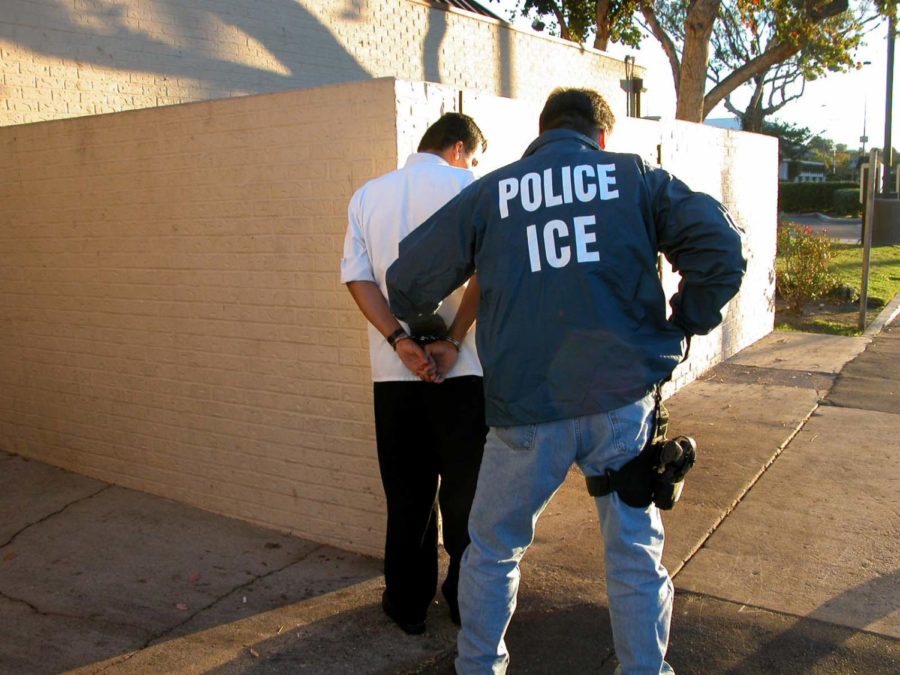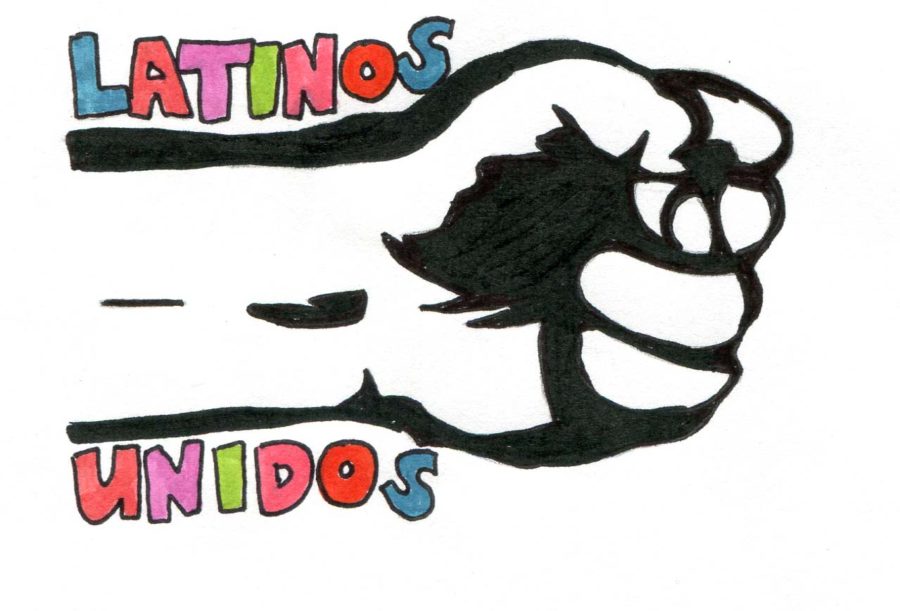Your donation will support the student journalists of San Juan Hills High School. Your contribution will allow us to cover our annual professional memberships as well as equipment and other costs associated with bringing you high quality student journalism.
Understanding A Rich Culture
October 25, 2018
Student Who Fears Deportation
Sitting and eating lunch, a typical Hispanic family enjoys each others presence, until the possibility of staying together could be ripped away with just one question: “Do you have your documents with you?”
“I remember the first time I saw border patrol with my parents. We were at a Subway and we were having food when my parents suddenly became really silent… you could see the fear, they were so uneasy,” expresses Carlos Mendoza, whose parents were previously undocumented.
Both his parents immigrated in their teens, yet it took them about eight years to become citizens.
“My parents applied to be citizens when I was in second or third grade and since then they had to take a lot of classes, talk to their lawyer, see if it would work out and it wasn’t until three years ago that they got their citizenship,” explains Mendoza.
It is a very lengthy process for an immigrant to get their citizenship and even once they do Mendoza feels that there is still paranoia because they can still all be deported.
Mendoza was born in the United States, but he remains very concerned for himself and his parents. “I know I’m a citizen, I was born here, but whenever I encounter an officer there’s always that fear. I carry my passport everywhere I go just because it’s been ingrained in me that I need to have a document to prove this is my home,” said Mendoza.
Before gaining citizenship, many restrictions were keeping Mendoza’s family from doing much outside of the house. “We couldn’t go past San Clemente because past that there’s checkpoints. I have family members that won’t even go to the beach anymore that often. There’s always that constant fear,” claims Mendoza.
“My parents immigrated to have a better life and there’s people immigrating because of safety,” said Mendoza. But these people are just as likely to be deported as someone who is a criminal. According to NBC News, under President Donald Trump’s administration, the amount of deported immigrants with no criminal record has tripled. “It shouldn’t be that way… [the government should] try to understand why they came here,” explains Mendoza.
Out of Mendoza’s family, his parents and siblings are the only ones documented. “So if anything were to happen we would be the only ones left here,” said Mendoza, and the rest of his extended family would be stuck in a helpless situation.
Many fears come from just the idea of deportation Mendoza explains.
“There’s that fear of, ‘if I leave where are my kids going to go? Where is my stuff going to go?’” expresses Mendoza. Parents immigrate usually to provide a better life for their children but if they are deported all that they have worked for, and their children can be ripped away from them.
“We’re very privileged with [being born in the U.S.]. A lot of my cousins are DREAMERS and under [Deferred Action for Childhood Arrivals or DACA], and [deportation] is a nag, it’s always pulling on you,” claims Mendoza.
There have been several attempts to remove DACA, however it protects almost 700,000 people. “People are trying to get rid of DACA but these children grew up here… they know nothing else,” explains Mendoza.
The main restriction of deportation, besides the constant fear, is traveling. “I have a friend that can’t go on the Senior trip because she’s undocumented and the trip is out of the country,” said Mendoza and “[My family] travels a lot… but we can’t really go past state lines.”
“[Deportation] brings us really close together, we’re always watching out for each other,” explains Mendoza.
Several organizations at SJHHS also watch out for and take care of the Hispanic community. “There’s a lot of students who are applying [to colleges] and their parents know how to help… but I’m in six different programs to help me since my parents didn’t go through it,” claims Mendoza.
Mendoza pushes himself and takes AP classes that is not usual of Latino students. “I’ll talk to everyone in the classes, but once we leave the classroom we live in separate worlds. It’s not the same,” said Mendoza. The fear of deportation is much more weighing than the fear of getting an F which is typical of students in high school.
As a white student sits at a restaurant, they don’t carry their passport and they don’t fear that their parents could be taken away at any moment but a Hispanic student, as Mendoza sees it, is often fearful of deportation and the random appearance of the border patrol can strike terror in their hearts.
Student Who Has Had a Family Member Deported
The memories of the experience are vague, but their emotional impact is lasting. Images of family members being hauled away without explanation by US Immigration and Customs Enforcement (ICE) are traumatizing and can never be forgotten. Deportation: a concept that instills a constant fear in the minds of some students at San Juan Hills High School.
“My family has been affected by deportation in two ways: My uncle was one of them. He was deported last year. He got deported because he was mistaken for someone else.They immediately took him. They just took him,” said Angelica Vasquez.
When ICE comes to take away an undocumented immigrant, there are no niceties offered; only hostility and force are used. Vasquez perceives that these events are what have a lasting traumatic affect not only on those who are deported, but their families.
“When it happened, my little cousins were there too because they woke up, and I had to watch them cry. It was so painful, having to see them cry. One of my cousins, my uncle’s son, has gotten much more angry and violent since the event last year. He was nine,” said Vasquez.
This experience of losing her uncle was not the beginning for Vasquez. When she was eight, her father was taken.
“It was one of my cousin’s birthday party, and my dad got deported during the party. He ran into our house, and [ICE], started taking every male inside. I was in kindergarten, so I didn’t really know what was happening. I just have some pictures in my head and remember how I was on the floor crying with my mom. He was deported and then wasn’t there for a whole year. A whole year of his absence,” said Vasquez.
Vasquez describes deportation not only as something that rips families apart abruptly, but as a loss that puts an extreme burden on those left behind.
“That year he was gone was extremely hard; my mom would have to leave me alone to go to work because she had to maintain our family by herself,” said Vasquez.
Experiencing the separation inflicted by ICE, families, like that of Vazquez, go through extreme emotional turmoil.
“Last year I stopped caring about my education. I was so much more worried about the danger my parents and I are in. I started to do a lot of research about deportation, like if my parents got deported, how I could get them back. I was beginning to drift from everyone and everything. I wouldn’t express myself to friends, and I’d be quiet all the time. Since I didn’t have a therapist last year, it was really hard not being able to talk about my feelings,” said Vasquez.
Vasquez explains that fear of ICE doesn’t go away: “Deportation is a constant fear. Next year I’m going to be eighteen. That is even scarier because I could be deported for no reason,” said Vasquez.
“A couple days ago I actually saw ICE in San Clemente. I was so scared, but my friend tried to reassure me that nothing would happen. We ended up arguing though because she has her papers and doesn’t have anything to be afraid of. I get in a lot of fights with my friends over this; it’s just that they aren’t able to fully understand my situation since they are here legally,” said Vasquez.
Vasquez feels that there are some people in the Orange County community that are extremely insensitive regarding the topic of deportation, and actively establish divides.
“My mom cleans houses, and one women told her that if she got deported, it would be fine; she would just find another maid. It’s not just one person being deported though, it’s so many, and eventually there won’t be anyone,” said Vasquez.
However, Vasquez believes that polarization and prejudice often permeate deeper into the sphere of Orange County and into SJHHS.
“There are distinct lines. There are different groups at our school, and some of them treat me and my friends…differently. Some of the most popular people at school are extremely racist towards us too. There’s this one boy that has some trouble speaking English, and most of the kids just laugh at him whenever he tries to speak. It gets me really upset because I can’t believe that there are some students that would do that. As a school we should be united and lift each other up,” said Vasquez.
Even though Vasquez, and many in the same position as her, wants to encourage change, there is still fear that prevents them from doing so.
“It’s just hard, because I want to participate in deportation protests, but I can’t. In the news, there are always stories about how undocumented students go to rallies, and they end up getting arrested and deported. It’s just one of my fears,” said Vasquez.
To promote change, Vasquez looks to everyone with the power to vote: “I tell all my friends that are eighteen to vote in order to elicit change in policy and in the attitude towards immigrants,” said Vasquez.
In regards to the continuous separation of families and the pain that results from it, Vasquez has one simple request. “Please, open up your eyes. I’m trying to get a better education and get my papers in order to help my family in the future. That’s all any of us want to do,” said Vasquez.
Student Who Feels Stigma Against Latino Community
An anonymous San Juan Hills alumni shares their experience in getting vaccinated in secret due to their parents fear and criticism towards the Covid-19 vaccine.
Being Latina for Luz Garcia was not something to be ashamed of at a young age. It was normal to celebrate such a rich culture, normal to dance late into the night with family members, and normal to speak a different language at home; but as Garcia approached high school things began to change.
“The Caucasians hang out with the Caucasians and the Mexicans hang out with the Mexicans. It’s very separate, but it would be much better if we could all be one school that supports each other,” claims Garcia.
Garcia is no longer in elementary school, where race did not play an important role. At SJHHS, she now finds herself uncomfortable in a lot of situations based solely on the color of her skin.
“Some Caucasians say ‘this is our country’… but we’re one big group,” said Garcia. She was born in the United States just like the people who claim that this is their country.
In high school, Garcia has experienced many other barriers from non Hispanic students. “I just don’t always feel comfortable. I feel like the upperclassmen have their own opinions that are more aggressive… and that they feel threatened [by us]. They patronize us… and they think they’re better than us,” explains Garcia.
Today’s political climate, as Garcia sees it, is very tense, which makes any difference of opinions hard to accept and has created a lot of controversy surrounding immigration.
“Every time I’m in history class and we talk about immigrants, I feel like everyone is looking at me. They always make everything so political, and I don’t understand why they can’t see us like everyone else,” said Garcia.
Regardless of political party or perspective, however, Garcia believes that people should not be discriminated against because of their race. “People say there’s so many Mexicans here as if it’s something negative, as if we don’t belong here. We’re not trying to [take over], we’re just trying to be a part of the school,” expresses Garcia.
“We belong here too, we deserve an opportunity, don’t just discriminate us because of the color of our skin,” claims Garcia.
At SJHHS, there is a lower percentage of involvement from Latino students especially in sports, school dances, or leadership classes such as ASB or Newspaper. But Garcia speculates that, as expected, often times Hispanics feel awkward in a setting that is predominantly white.
As a minority, Garcia feels that sports teams and classes can be very discouraging. Joining a soccer team is preferable for a Latino student than joining golf or football because there is a stronger sense of community on the soccer team and other teams will be more uneasy.
No one wants to spend time in an unwelcoming environment, hence the lower participation of Hispanic students. Garcia has seen that many non Hispanic communities create atmospheres uncomfortable to the point where Garcia feels tense every minute she is there, and she perceives it is the same for many other Latino students.
“I feel like AVID always has my back but [otherwise] it’s kind of everyone for themselves and I don’t feel as close [to others],” expresses Garcia.
“People are constantly saying negative things, and I respect their point of view, but it gets to the point where they’re just throwing insults directly at a person,” claims Garcia. This type of behavior, as Garcia sees it, is experienced by many Hispanic students due to the stereotypes that the United States society has portrayed over the recent years.
“People make it seem like Latinos and everything they represent is bad, but we bring so much culture, tradition, and music” said Garcia, “they see Latinos, Mexicans, Hispanics, or anyone brown as one singular identity, as if we are all criminals, but we aren’t.”
The culture Garcia’s family and the rest of the Hispanic population in the United States brings is special and unique in it’s own way. “If people could just see how good our culture is and what we have to offer then I feel like they would want to be a part of it,” explains Garcia.
“Everything that Hispanics do is really family based… We love to enjoy music, be happy, we have traditions, and we have festivals. We celebrate so many things and have such a rich culture,” claims Garcia.
The Hispanic communities and Garcia do not understand what they have done to receive such hate from others. “If only they knew how we felt every time we heard all their hateful comments. I did not choose my race or ethnicity but I am not ashamed of who I am,” expresses Garcia.
“There are some Caucasians that are supportive yet some feel superior just based on the color of their skin… If only it were like kindergarten again, when nobody cared about the way you looked, all you did was play and have fun together,” said Garcia.
Photo courtesy of Wikimedia Commons
Un agente de Inmigracion y Control de Aduanas de los Estados Unidos arresta a un sospechoso.
ICE Under Scrutiny as Arrests Continue
Throughout the past two years, US Immigration and Customs Enforcement (ICE) has taken a center stage in the public eye. It is praised by some, criticized by others, and always under intense scrutiny, as the work it does is often another cause of partisan divide.
Some regard ICE fondly with a sense of patriotism. They believe the work ICE does protects everyday Americans. For others, the thought of ICE brings up images of chaos and terror, children being ripped from their mothers’ arms, and guns pointed at innocent people.
ICE was created in the aftermath of the September 11, 2001 terrorist attacks, replacing the INS (Immigration and Naturalization Service). While the laws that ICE enforces haven’t changed since the replacement of the Obama administration with the Trump administration, the way they are enforced is controlled by the President, often through executive orders.
Under President Trump’s first 14 months in office the numbers of arrests and deportations increased compared to Obama’s last years in office, and are projected to continue rising.
The amount of arrests made by ICE have tripled compared to the final months of Obama’s administration, according to an NBC News study published in August. Federal arrests of undocumented immigrants with no criminal records has surged 203%, from 19,128 people to 58,010, and arrests of immigrants with a criminal record have rose by 18%.
The Obama administration made more arrests than any president before him: upwards of two million during his eight years in office. Many even called him the “deporter-in-chief.” Yet the difference that seems to separate the Obama and Trump administration is that ICE under Obama targeted those convicted of a serious crime, gang members, and other threats to national security, while the Trump administration seems to target all undocumented immigrants, regardless of past criminal activity.
“Many aliens who illegally enter the United States and those who overstay or otherwise violate the terms of their visas present a significant threat to national security and public safety. This is particularly so for aliens who engage in criminal conduct in the United States,” said President Trump in an executive order signed in January 2017.
Many attribute the rise in arrests to new tactics of finding undocumented immigrants. ICE no longer uses search warrants to seek out potential undocumented immigrants. People walking down the street or driving in their car could be stopped and detained at any moment. There are even random sweeps and mass arrests at workplaces.
“What’s really different about this enforcement action is that they are literally doing roving stops, whether by car or on foot, stopping people without any sort of articulable facts,” said Mark Fleming from the National Immigrant Justice Center.
Americans often attribute family separation at the border to ICE, even though ICE is only in charge of deporting those already inside the US. Customs and Border Protection controls the borders. It is because of President Trump’s “zero tolerance policy” that adults are being immediately arrested at the border by the CBP, separating them from their children.
These changes won’t affect CUSD. California Education Code protects students from discrimination on the basis of their race or immigration status.
“Federal law provides for equal access to a public elementary and secondary education regardless of a child’s actual or perceived race…citizenship, immigration status or the status of their parents/guardians,” said Superintendent Kristen Vital in an email sent to all CUSD families in 2017.
Not many of the laws that ICE follows have changed, but the “net” ICE is using to catch undocumented immigrants has widened due to the new administration. Many who had a sense of security at the end of the Obama administration are now questioning the safety they once felt.
Latinos Unidos, Nuestros Amigos
Latinos Unidos club, created last year, seeks to involve Latino students in more extracurricular activities, leadership events, and sports at SJHHS.
Spanish teacher and club advisor, Fernanda Villalba, said “the goal is to create a better presence of this minority group we have here at SJHHS.” She works alongside academic advisor, Fernando Sotelo, who plays a key role in advocating for undocumented, and dreamer students in our school.
As a whole, the club is a resource for the Latino students of SJHHS, as well as a safe space for them to feel known and understood. The club hopes to give its attendees opportunities as well as get them involved in more activities at the school. They bring in sources and resources for the students that explain topics such as the California Dream Act, accessibility to higher education, opportunities for latino youth in the community, and more.
Not only can Latino students join to find new friends and gain further information about their future, all students can join and discuss various topics in order to bring awareness, in the right way.
It is important that all students are given an access to education beyond high school and this club is beneficial in making students aware of their path to get there as well as letting them know that they are not alone in the process.
All students are encouraged and welcomed to participate with the club and come to meetings. “We are all one here. We all RFTB. Whatever background you have, whatever citizenship status you have, it doesn’t matter, we are all Stallions,” said Sotelo.
Unafraid Educators Movement Continues to Grow
History tecaher, John Baker, holds one of the many posters that are all around teacher’s rooms at SJHHS. By stating that the teachers are unafraid to educate undocumented students, it is a hope that DACA recipients will feel comfortable and accepted at SJHHS.
The Boston Teachers Union created the Unafraid Educators Movement as a way of reassuring students that regardless of one’s immigration status in America, they are safe, and are encouraged to learn no matter what.
After attending the first annual undocumented conference and San Diego State University, Academic Advisor, Fernando Sotelo, was inspired to bring the Unafraid Educators Movement to SJHHS.
“We didn’t really offer any real support in regards to college access for undocumented students. We knew information, but I don’t think the students were aware that we have information that they could utilize,” Sotelo said.
After touching base with some teachers, clubs were created and night time events were held to spread information about what undocumented students can be doing, and what the community can be doing in support.
“A lot of the time, I heard the same thing. Either the student was too afraid to approach somebody, and disclose their status, they didn’t know who to go to, or if they went to somebody, they didn’t have much information. So that’s what mainly I wanted to do here, was be able to fill those gaps,” Sotelo said.
Federal law provides for equal access to a public elementary and secondary education regardless of a child’s actual or perceived race, color, national origin, sexual orientation, gender identity, citizenship, immigration status, or the status of their parents or guardians.
The Unafraid Educators Movement encourages equal opportunities for success no matter the status of a student, especially at SJHHS.






